Developing Manager Report: Leadership, Skills and Development
VerifiedAdded on 2021/02/20
|18
|5015
|22
Report
AI Summary
This report delves into the multifaceted concept of developing management, exploring its principles and practices within the context of the Clayton Crown Hotel and Thomas Cook. It begins by comparing different management styles, including scientific, systematic, and bureaucratic approaches, followed by an examination of various leadership characteristics such as autocratic, democratic, and laissez-faire styles. The report then evaluates the communication processes within the Clayton Crown Hotel, highlighting the importance of verbal, written, and technological communication. Furthermore, it analyzes organizational culture and change in selected businesses, discussing functional, divisional, and matrix structures. A significant portion of the report is dedicated to self-assessment, where the author evaluates their own management skills, identifies strengths and weaknesses, and outlines a plan for personal development. Finally, the report addresses leading and motivating a team, justifying managerial decisions, and explaining managerial and personal skills through career development, ultimately providing a comprehensive overview of the key aspects of developing management.
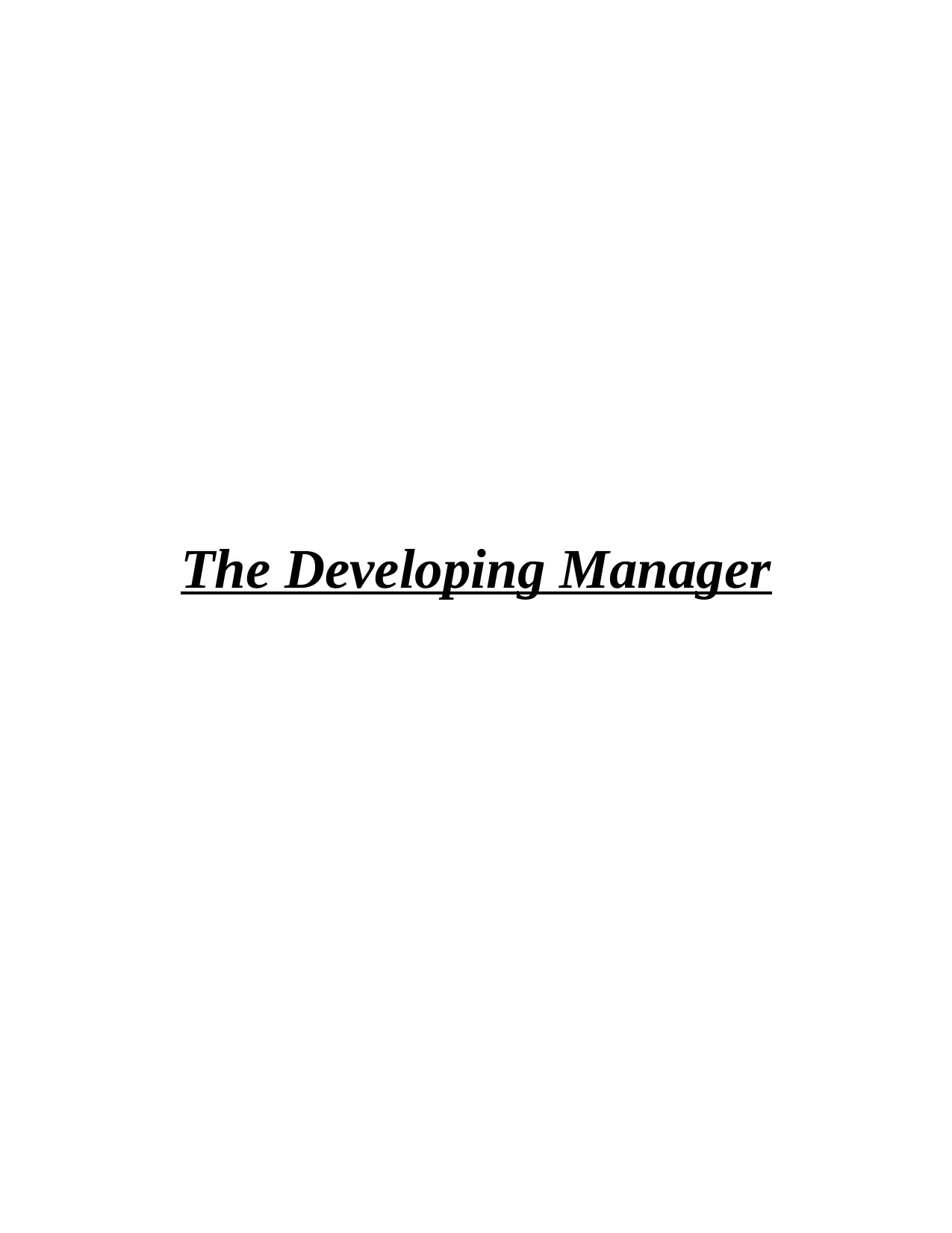
The Developing Manager
Paraphrase This Document
Need a fresh take? Get an instant paraphrase of this document with our AI Paraphraser
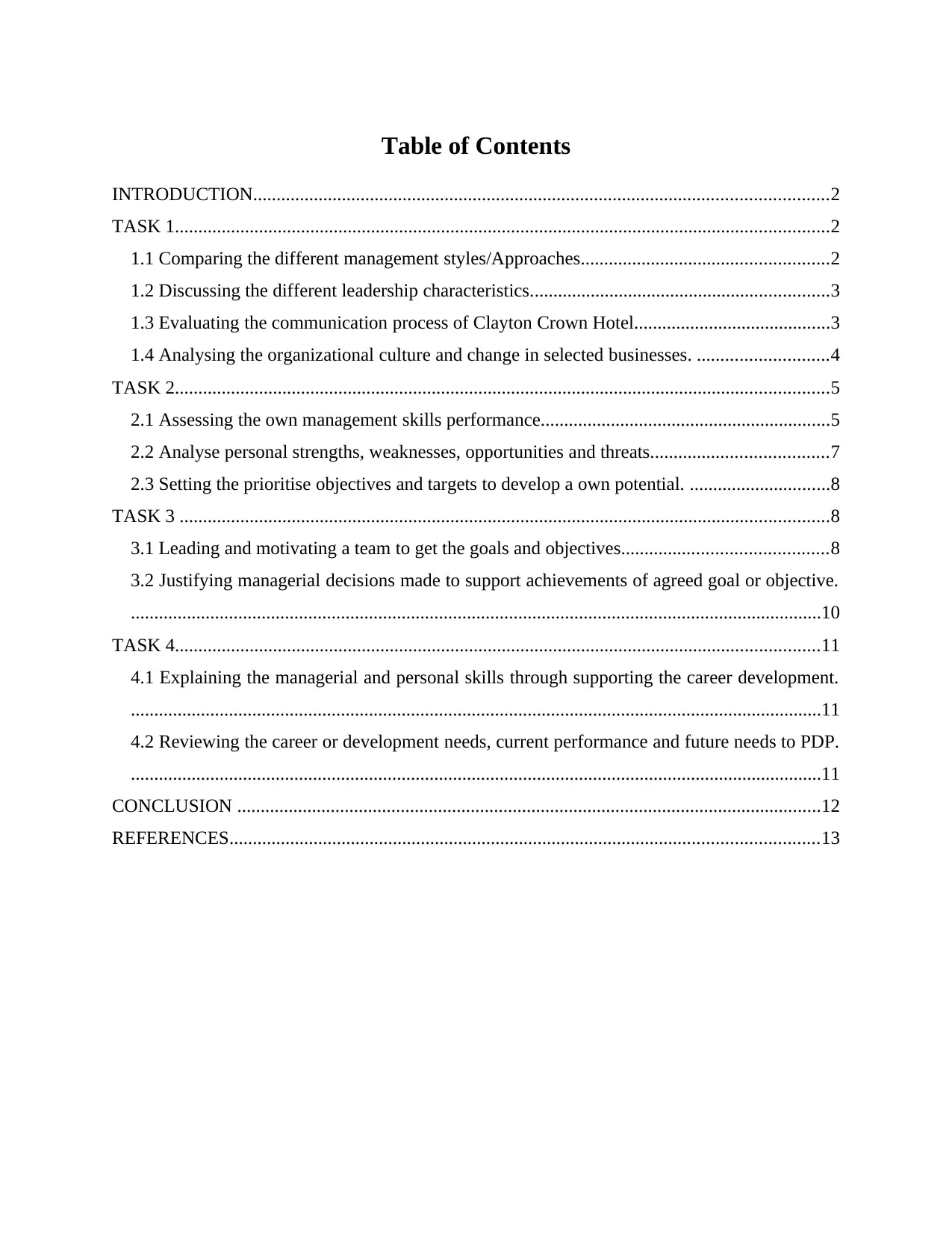
Table of Contents
INTRODUCTION...........................................................................................................................2
TASK 1............................................................................................................................................2
1.1 Comparing the different management styles/Approaches.....................................................2
1.2 Discussing the different leadership characteristics................................................................3
1.3 Evaluating the communication process of Clayton Crown Hotel..........................................3
1.4 Analysing the organizational culture and change in selected businesses. ............................4
TASK 2............................................................................................................................................5
2.1 Assessing the own management skills performance..............................................................5
2.2 Analyse personal strengths, weaknesses, opportunities and threats......................................7
2.3 Setting the prioritise objectives and targets to develop a own potential. ..............................8
TASK 3 ...........................................................................................................................................8
3.1 Leading and motivating a team to get the goals and objectives............................................8
3.2 Justifying managerial decisions made to support achievements of agreed goal or objective.
....................................................................................................................................................10
TASK 4..........................................................................................................................................11
4.1 Explaining the managerial and personal skills through supporting the career development.
....................................................................................................................................................11
4.2 Reviewing the career or development needs, current performance and future needs to PDP.
....................................................................................................................................................11
CONCLUSION .............................................................................................................................12
REFERENCES..............................................................................................................................13
INTRODUCTION...........................................................................................................................2
TASK 1............................................................................................................................................2
1.1 Comparing the different management styles/Approaches.....................................................2
1.2 Discussing the different leadership characteristics................................................................3
1.3 Evaluating the communication process of Clayton Crown Hotel..........................................3
1.4 Analysing the organizational culture and change in selected businesses. ............................4
TASK 2............................................................................................................................................5
2.1 Assessing the own management skills performance..............................................................5
2.2 Analyse personal strengths, weaknesses, opportunities and threats......................................7
2.3 Setting the prioritise objectives and targets to develop a own potential. ..............................8
TASK 3 ...........................................................................................................................................8
3.1 Leading and motivating a team to get the goals and objectives............................................8
3.2 Justifying managerial decisions made to support achievements of agreed goal or objective.
....................................................................................................................................................10
TASK 4..........................................................................................................................................11
4.1 Explaining the managerial and personal skills through supporting the career development.
....................................................................................................................................................11
4.2 Reviewing the career or development needs, current performance and future needs to PDP.
....................................................................................................................................................11
CONCLUSION .............................................................................................................................12
REFERENCES..............................................................................................................................13

1
⊘ This is a preview!⊘
Do you want full access?
Subscribe today to unlock all pages.

Trusted by 1+ million students worldwide
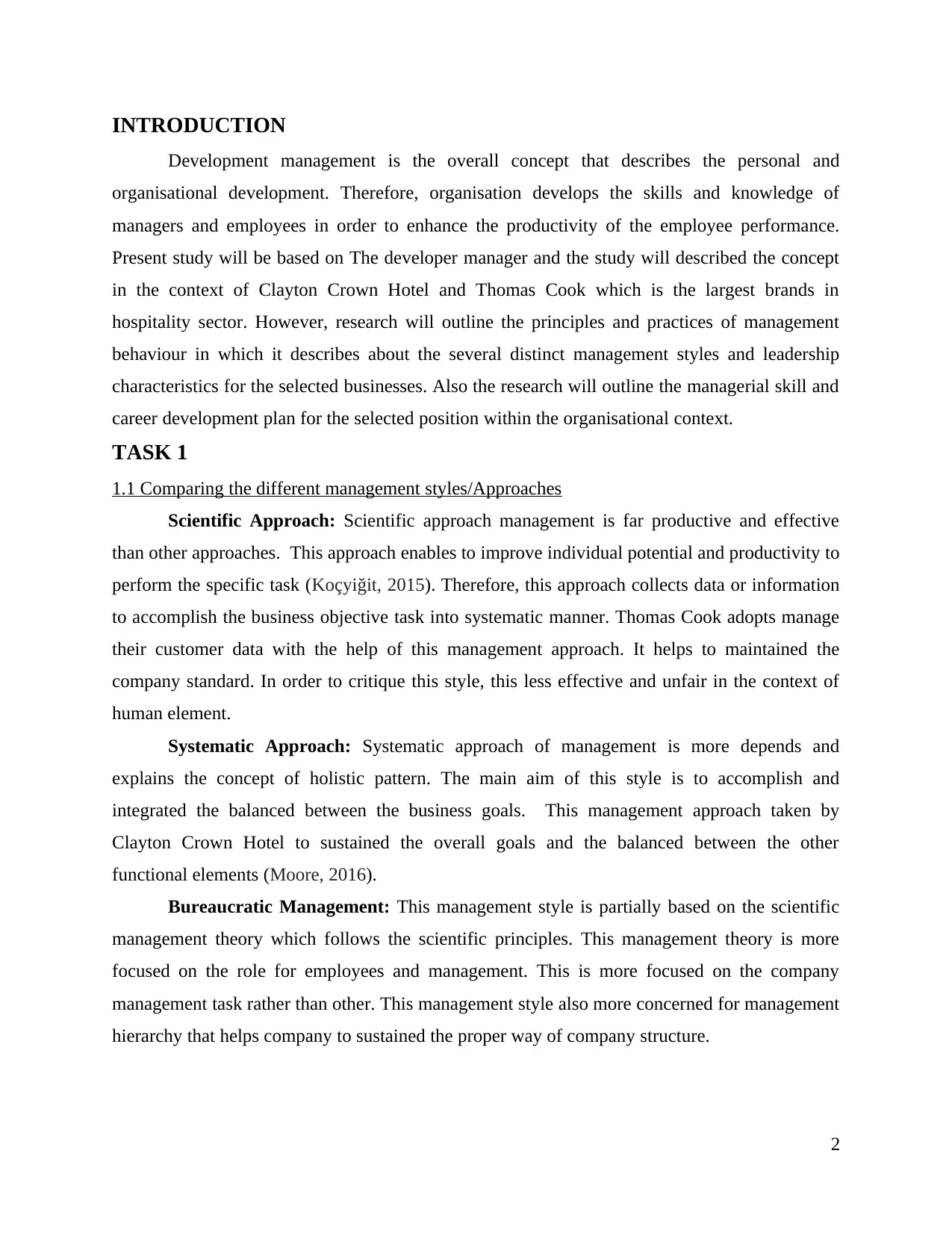
INTRODUCTION
Development management is the overall concept that describes the personal and
organisational development. Therefore, organisation develops the skills and knowledge of
managers and employees in order to enhance the productivity of the employee performance.
Present study will be based on The developer manager and the study will described the concept
in the context of Clayton Crown Hotel and Thomas Cook which is the largest brands in
hospitality sector. However, research will outline the principles and practices of management
behaviour in which it describes about the several distinct management styles and leadership
characteristics for the selected businesses. Also the research will outline the managerial skill and
career development plan for the selected position within the organisational context.
TASK 1
1.1 Comparing the different management styles/Approaches
Scientific Approach: Scientific approach management is far productive and effective
than other approaches. This approach enables to improve individual potential and productivity to
perform the specific task (Koçyiğit, 2015). Therefore, this approach collects data or information
to accomplish the business objective task into systematic manner. Thomas Cook adopts manage
their customer data with the help of this management approach. It helps to maintained the
company standard. In order to critique this style, this less effective and unfair in the context of
human element.
Systematic Approach: Systematic approach of management is more depends and
explains the concept of holistic pattern. The main aim of this style is to accomplish and
integrated the balanced between the business goals. This management approach taken by
Clayton Crown Hotel to sustained the overall goals and the balanced between the other
functional elements (Moore, 2016).
Bureaucratic Management: This management style is partially based on the scientific
management theory which follows the scientific principles. This management theory is more
focused on the role for employees and management. This is more focused on the company
management task rather than other. This management style also more concerned for management
hierarchy that helps company to sustained the proper way of company structure.
2
Development management is the overall concept that describes the personal and
organisational development. Therefore, organisation develops the skills and knowledge of
managers and employees in order to enhance the productivity of the employee performance.
Present study will be based on The developer manager and the study will described the concept
in the context of Clayton Crown Hotel and Thomas Cook which is the largest brands in
hospitality sector. However, research will outline the principles and practices of management
behaviour in which it describes about the several distinct management styles and leadership
characteristics for the selected businesses. Also the research will outline the managerial skill and
career development plan for the selected position within the organisational context.
TASK 1
1.1 Comparing the different management styles/Approaches
Scientific Approach: Scientific approach management is far productive and effective
than other approaches. This approach enables to improve individual potential and productivity to
perform the specific task (Koçyiğit, 2015). Therefore, this approach collects data or information
to accomplish the business objective task into systematic manner. Thomas Cook adopts manage
their customer data with the help of this management approach. It helps to maintained the
company standard. In order to critique this style, this less effective and unfair in the context of
human element.
Systematic Approach: Systematic approach of management is more depends and
explains the concept of holistic pattern. The main aim of this style is to accomplish and
integrated the balanced between the business goals. This management approach taken by
Clayton Crown Hotel to sustained the overall goals and the balanced between the other
functional elements (Moore, 2016).
Bureaucratic Management: This management style is partially based on the scientific
management theory which follows the scientific principles. This management theory is more
focused on the role for employees and management. This is more focused on the company
management task rather than other. This management style also more concerned for management
hierarchy that helps company to sustained the proper way of company structure.
2
Paraphrase This Document
Need a fresh take? Get an instant paraphrase of this document with our AI Paraphraser
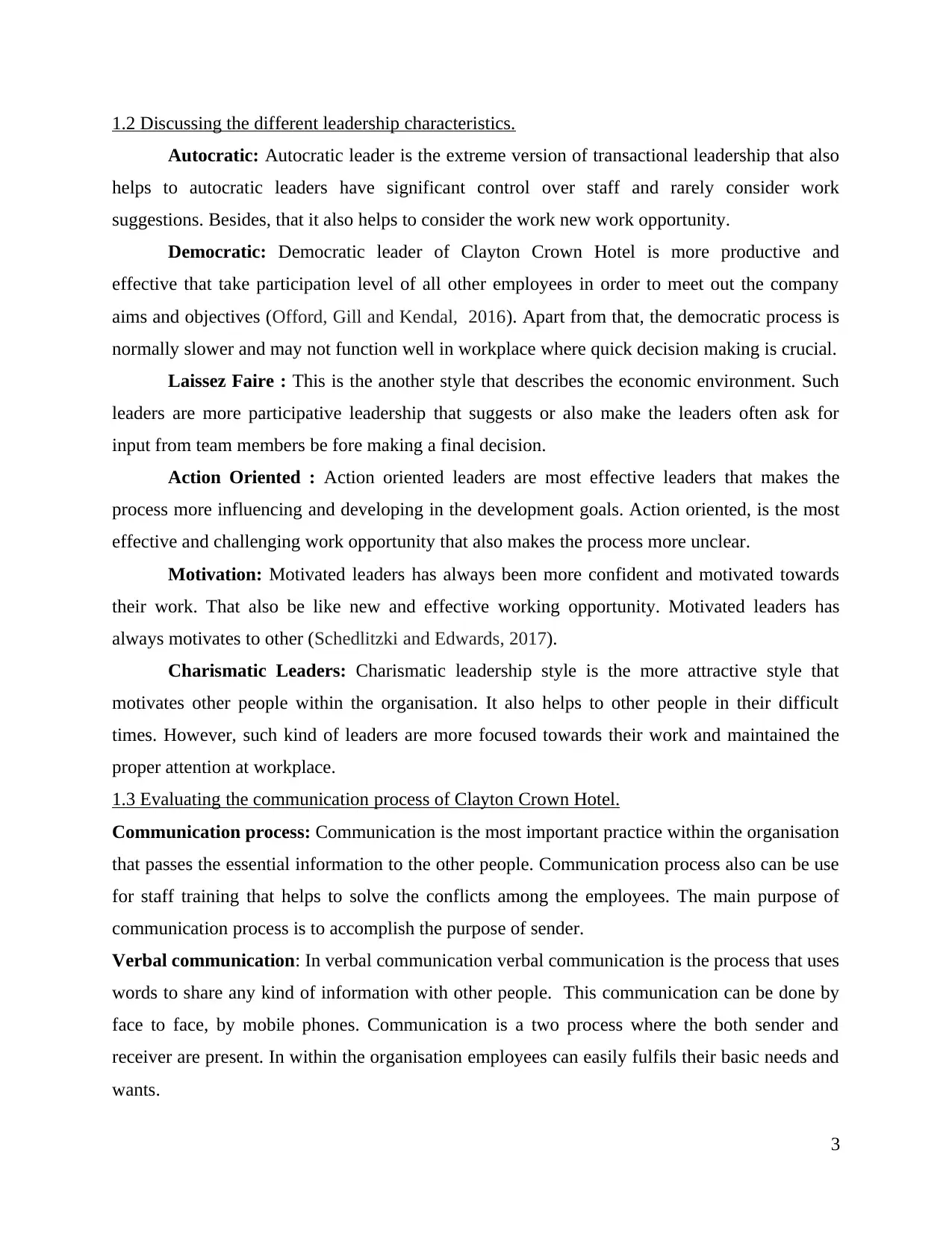
1.2 Discussing the different leadership characteristics.
Autocratic: Autocratic leader is the extreme version of transactional leadership that also
helps to autocratic leaders have significant control over staff and rarely consider work
suggestions. Besides, that it also helps to consider the work new work opportunity.
Democratic: Democratic leader of Clayton Crown Hotel is more productive and
effective that take participation level of all other employees in order to meet out the company
aims and objectives (Offord, Gill and Kendal, 2016). Apart from that, the democratic process is
normally slower and may not function well in workplace where quick decision making is crucial.
Laissez Faire : This is the another style that describes the economic environment. Such
leaders are more participative leadership that suggests or also make the leaders often ask for
input from team members be fore making a final decision.
Action Oriented : Action oriented leaders are most effective leaders that makes the
process more influencing and developing in the development goals. Action oriented, is the most
effective and challenging work opportunity that also makes the process more unclear.
Motivation: Motivated leaders has always been more confident and motivated towards
their work. That also be like new and effective working opportunity. Motivated leaders has
always motivates to other (Schedlitzki and Edwards, 2017).
Charismatic Leaders: Charismatic leadership style is the more attractive style that
motivates other people within the organisation. It also helps to other people in their difficult
times. However, such kind of leaders are more focused towards their work and maintained the
proper attention at workplace.
1.3 Evaluating the communication process of Clayton Crown Hotel.
Communication process: Communication is the most important practice within the organisation
that passes the essential information to the other people. Communication process also can be use
for staff training that helps to solve the conflicts among the employees. The main purpose of
communication process is to accomplish the purpose of sender.
Verbal communication: In verbal communication verbal communication is the process that uses
words to share any kind of information with other people. This communication can be done by
face to face, by mobile phones. Communication is a two process where the both sender and
receiver are present. In within the organisation employees can easily fulfils their basic needs and
wants.
3
Autocratic: Autocratic leader is the extreme version of transactional leadership that also
helps to autocratic leaders have significant control over staff and rarely consider work
suggestions. Besides, that it also helps to consider the work new work opportunity.
Democratic: Democratic leader of Clayton Crown Hotel is more productive and
effective that take participation level of all other employees in order to meet out the company
aims and objectives (Offord, Gill and Kendal, 2016). Apart from that, the democratic process is
normally slower and may not function well in workplace where quick decision making is crucial.
Laissez Faire : This is the another style that describes the economic environment. Such
leaders are more participative leadership that suggests or also make the leaders often ask for
input from team members be fore making a final decision.
Action Oriented : Action oriented leaders are most effective leaders that makes the
process more influencing and developing in the development goals. Action oriented, is the most
effective and challenging work opportunity that also makes the process more unclear.
Motivation: Motivated leaders has always been more confident and motivated towards
their work. That also be like new and effective working opportunity. Motivated leaders has
always motivates to other (Schedlitzki and Edwards, 2017).
Charismatic Leaders: Charismatic leadership style is the more attractive style that
motivates other people within the organisation. It also helps to other people in their difficult
times. However, such kind of leaders are more focused towards their work and maintained the
proper attention at workplace.
1.3 Evaluating the communication process of Clayton Crown Hotel.
Communication process: Communication is the most important practice within the organisation
that passes the essential information to the other people. Communication process also can be use
for staff training that helps to solve the conflicts among the employees. The main purpose of
communication process is to accomplish the purpose of sender.
Verbal communication: In verbal communication verbal communication is the process that uses
words to share any kind of information with other people. This communication can be done by
face to face, by mobile phones. Communication is a two process where the both sender and
receiver are present. In within the organisation employees can easily fulfils their basic needs and
wants.
3

Written communication: written communication is the another types of communication process.
Written communication involves the process which is majorly company adopted in formal
process. Written communication has been done in several manners such as Memos, Reports,
Bulletins, job description, employee manuals, Emails and instant messages. The advantage of
this communication process is no need for personal contacts, it saves the extra cost to the
company. It also helpful for the businesses to be more effective and written management styles.
Written proof provides legal affectivity within the business (Shah, Shah and Pathan, 2017).
Effectiveness of Communication technology
Effective Technology has always been given the good impact on the overall situation of
the business that contains the business organization and objective. Such as Technology is helpful
to continue the evolution of Email. E-mail, direct indirect communication. Highly influenced
business is the opportunity for the business that innovate the business opportunity. Continued
evolution. Continued evolution of Email. Project management system and scheduling. For
example Artificial intelligence system is the another important source of the technology that
generate more opportunity for the business.
For Example : Thomas Cook can organize video conferences for the virtual employees
whose working at different locations of the company. Such kind of communication atmosphere
can develop the efficient environment within the business culture.
1.4 Analysing the organizational culture and change in selected businesses.
Organization culture is off different types such as functional, divisional structure, divisional
structure typically used in larger companies that operates in a wide geographic area. Functional
structure consists the different function within the organization such as marketing, financial, HR,
operational, R&D etc. on the other side, Divisional structure of the company in which business
operates a wide geographic area or that have separate smaller organization. The benefit of this
department is that it enables to fulfil the needs more rapidly and more specifically.
Another business structure is matrix structure of an organization is that another hybrid of
divisional and functional structure (Su and Baird, 2018). This is more effective and more
enlisting the working opportunity and task to be more energetic performing task. Matrix is the
hybrid structure of divisional and functional structure. The benefit of this structure is fast
processing and better understanding between the employees within the organization. Matrix
structure basically adopted by those firms whose having the project based work.
4
Written communication involves the process which is majorly company adopted in formal
process. Written communication has been done in several manners such as Memos, Reports,
Bulletins, job description, employee manuals, Emails and instant messages. The advantage of
this communication process is no need for personal contacts, it saves the extra cost to the
company. It also helpful for the businesses to be more effective and written management styles.
Written proof provides legal affectivity within the business (Shah, Shah and Pathan, 2017).
Effectiveness of Communication technology
Effective Technology has always been given the good impact on the overall situation of
the business that contains the business organization and objective. Such as Technology is helpful
to continue the evolution of Email. E-mail, direct indirect communication. Highly influenced
business is the opportunity for the business that innovate the business opportunity. Continued
evolution. Continued evolution of Email. Project management system and scheduling. For
example Artificial intelligence system is the another important source of the technology that
generate more opportunity for the business.
For Example : Thomas Cook can organize video conferences for the virtual employees
whose working at different locations of the company. Such kind of communication atmosphere
can develop the efficient environment within the business culture.
1.4 Analysing the organizational culture and change in selected businesses.
Organization culture is off different types such as functional, divisional structure, divisional
structure typically used in larger companies that operates in a wide geographic area. Functional
structure consists the different function within the organization such as marketing, financial, HR,
operational, R&D etc. on the other side, Divisional structure of the company in which business
operates a wide geographic area or that have separate smaller organization. The benefit of this
department is that it enables to fulfil the needs more rapidly and more specifically.
Another business structure is matrix structure of an organization is that another hybrid of
divisional and functional structure (Su and Baird, 2018). This is more effective and more
enlisting the working opportunity and task to be more energetic performing task. Matrix is the
hybrid structure of divisional and functional structure. The benefit of this structure is fast
processing and better understanding between the employees within the organization. Matrix
structure basically adopted by those firms whose having the project based work.
4
⊘ This is a preview!⊘
Do you want full access?
Subscribe today to unlock all pages.

Trusted by 1+ million students worldwide
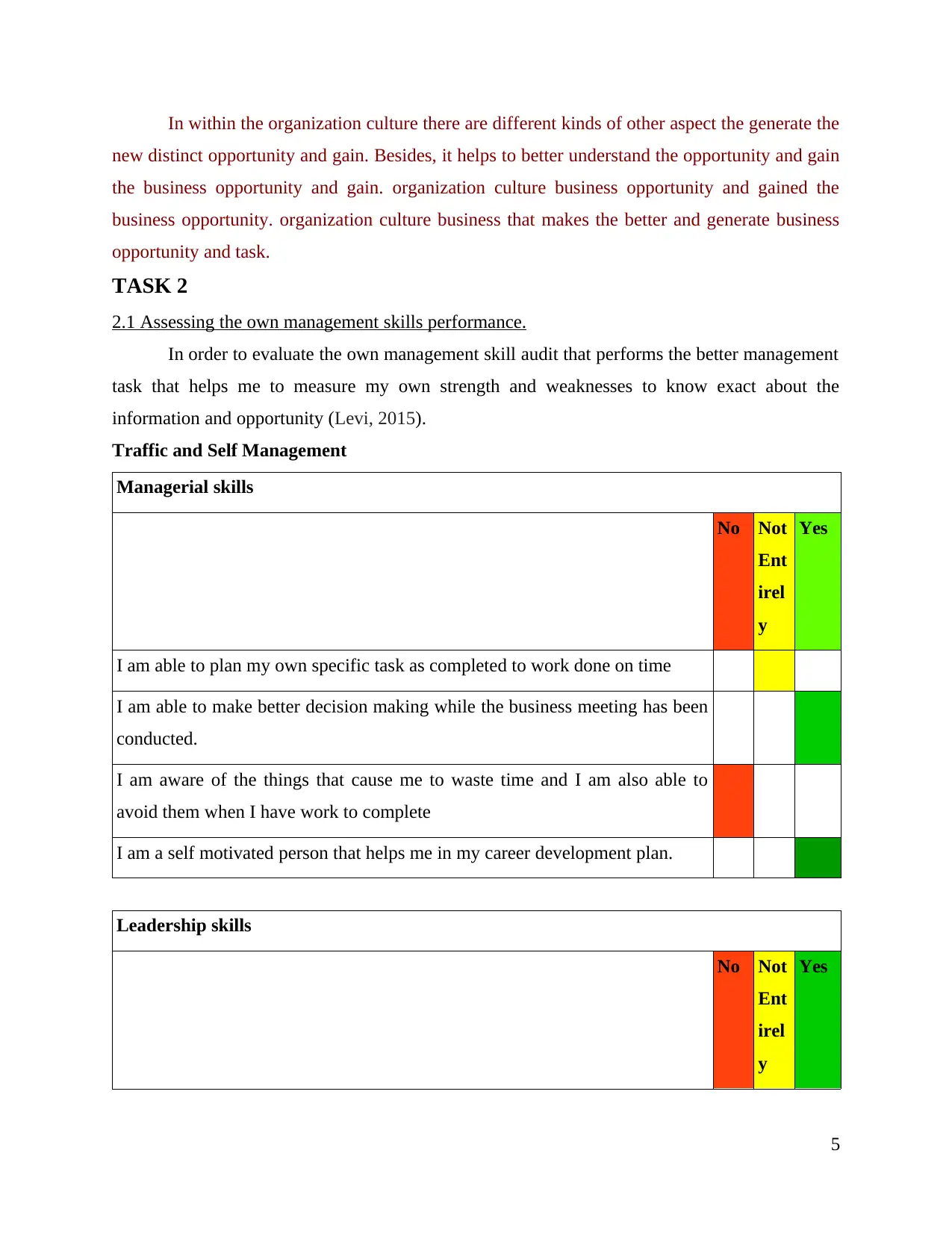
In within the organization culture there are different kinds of other aspect the generate the
new distinct opportunity and gain. Besides, it helps to better understand the opportunity and gain
the business opportunity and gain. organization culture business opportunity and gained the
business opportunity. organization culture business that makes the better and generate business
opportunity and task.
TASK 2
2.1 Assessing the own management skills performance.
In order to evaluate the own management skill audit that performs the better management
task that helps me to measure my own strength and weaknesses to know exact about the
information and opportunity (Levi, 2015).
Traffic and Self Management
Managerial skills
No Not
Ent
irel
y
Yes
I am able to plan my own specific task as completed to work done on time
I am able to make better decision making while the business meeting has been
conducted.
I am aware of the things that cause me to waste time and I am also able to
avoid them when I have work to complete
I am a self motivated person that helps me in my career development plan.
Leadership skills
No Not
Ent
irel
y
Yes
5
new distinct opportunity and gain. Besides, it helps to better understand the opportunity and gain
the business opportunity and gain. organization culture business opportunity and gained the
business opportunity. organization culture business that makes the better and generate business
opportunity and task.
TASK 2
2.1 Assessing the own management skills performance.
In order to evaluate the own management skill audit that performs the better management
task that helps me to measure my own strength and weaknesses to know exact about the
information and opportunity (Levi, 2015).
Traffic and Self Management
Managerial skills
No Not
Ent
irel
y
Yes
I am able to plan my own specific task as completed to work done on time
I am able to make better decision making while the business meeting has been
conducted.
I am aware of the things that cause me to waste time and I am also able to
avoid them when I have work to complete
I am a self motivated person that helps me in my career development plan.
Leadership skills
No Not
Ent
irel
y
Yes
5
Paraphrase This Document
Need a fresh take? Get an instant paraphrase of this document with our AI Paraphraser
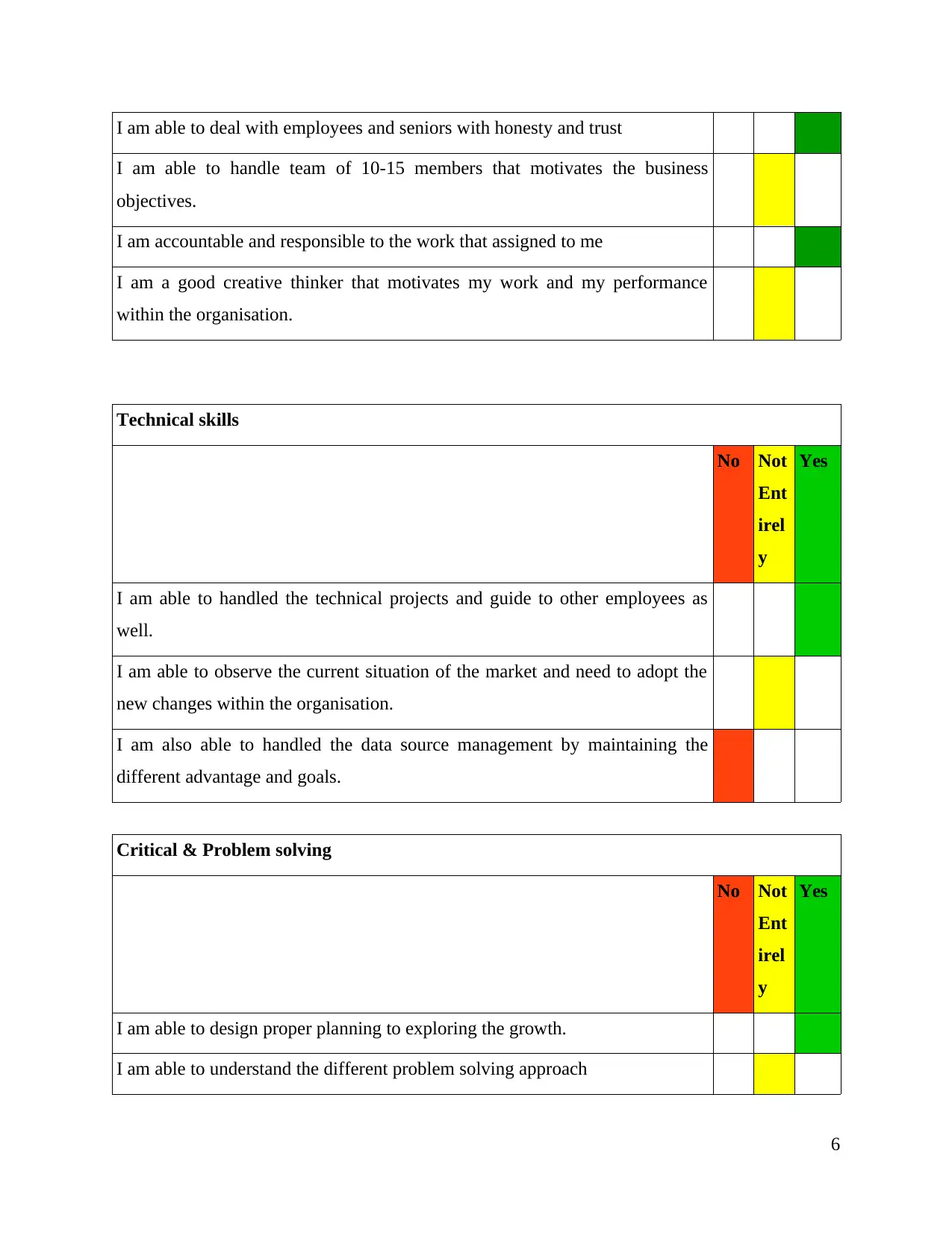
I am able to deal with employees and seniors with honesty and trust
I am able to handle team of 10-15 members that motivates the business
objectives.
I am accountable and responsible to the work that assigned to me
I am a good creative thinker that motivates my work and my performance
within the organisation.
Technical skills
No Not
Ent
irel
y
Yes
I am able to handled the technical projects and guide to other employees as
well.
I am able to observe the current situation of the market and need to adopt the
new changes within the organisation.
I am also able to handled the data source management by maintaining the
different advantage and goals.
Critical & Problem solving
No Not
Ent
irel
y
Yes
I am able to design proper planning to exploring the growth.
I am able to understand the different problem solving approach
6
I am able to handle team of 10-15 members that motivates the business
objectives.
I am accountable and responsible to the work that assigned to me
I am a good creative thinker that motivates my work and my performance
within the organisation.
Technical skills
No Not
Ent
irel
y
Yes
I am able to handled the technical projects and guide to other employees as
well.
I am able to observe the current situation of the market and need to adopt the
new changes within the organisation.
I am also able to handled the data source management by maintaining the
different advantage and goals.
Critical & Problem solving
No Not
Ent
irel
y
Yes
I am able to design proper planning to exploring the growth.
I am able to understand the different problem solving approach
6

I am able to break down a complex problem that also motivates the work out
goals.
I am able to work productively with others to solve problems.
On the basis of above defined skills performance audit that analyse and helped me to
measure my own performance areas and how I performed in the organisation (Noe and et.al.,
2017). This process helps me to analyse the work opportunities and targets to understand the
better goal opportunity task.
2.2 Analyse personal strengths, weaknesses, opportunities and threats.
In order to prepare the further development plan, for that the next process is to identify
the personal strength, weaknesses, opportunity and threat (Geissdoerfer, Bocken and Hultink,
2016).
Strength
I have a decision making skills which
strengthen my abilities towards my
goals & objectives.
I am self motivated person which is my
biggest strength that makes me more
confident and successful.
I am Task oriented person that is my
strength to handle any kind of situation.
My strength is my honesty that makes
my personality more effective and
productive in front my seniors.
I can also handled technical projects as
well.
I am good planner which enables me to
accomplish my task in systematic
manner.
Weaknesses
My weakness is I am not able to predict
things easily that makes my forecasting
skills low.
I am weak to handled the data
information in technical manner.
Sometimes, in uncertainties and
unstable set of mind can affect me and
restrict me to make the proper
decisions.
Opportunity Threats
7
goals.
I am able to work productively with others to solve problems.
On the basis of above defined skills performance audit that analyse and helped me to
measure my own performance areas and how I performed in the organisation (Noe and et.al.,
2017). This process helps me to analyse the work opportunities and targets to understand the
better goal opportunity task.
2.2 Analyse personal strengths, weaknesses, opportunities and threats.
In order to prepare the further development plan, for that the next process is to identify
the personal strength, weaknesses, opportunity and threat (Geissdoerfer, Bocken and Hultink,
2016).
Strength
I have a decision making skills which
strengthen my abilities towards my
goals & objectives.
I am self motivated person which is my
biggest strength that makes me more
confident and successful.
I am Task oriented person that is my
strength to handle any kind of situation.
My strength is my honesty that makes
my personality more effective and
productive in front my seniors.
I can also handled technical projects as
well.
I am good planner which enables me to
accomplish my task in systematic
manner.
Weaknesses
My weakness is I am not able to predict
things easily that makes my forecasting
skills low.
I am weak to handled the data
information in technical manner.
Sometimes, in uncertainties and
unstable set of mind can affect me and
restrict me to make the proper
decisions.
Opportunity Threats
7
⊘ This is a preview!⊘
Do you want full access?
Subscribe today to unlock all pages.

Trusted by 1+ million students worldwide
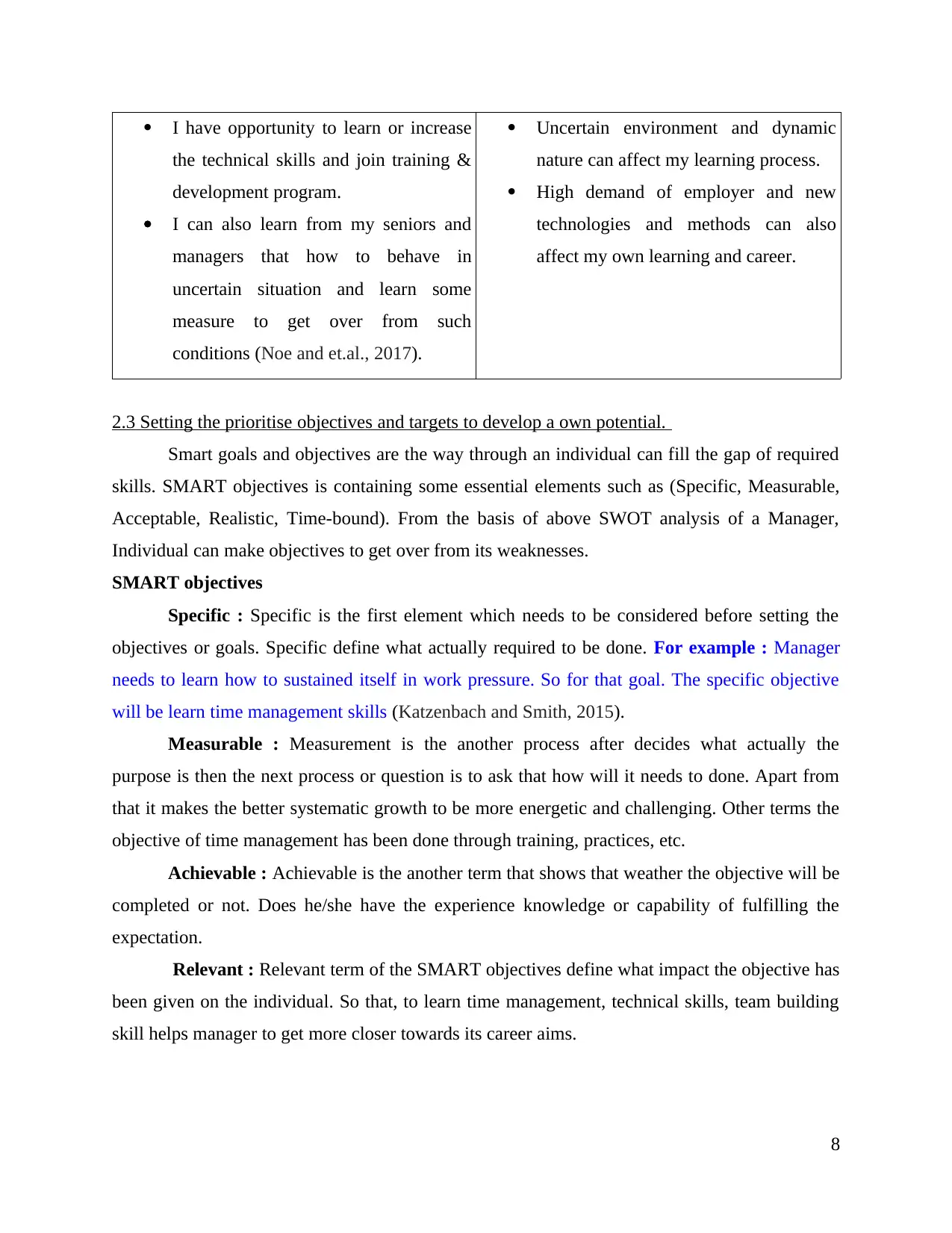
I have opportunity to learn or increase
the technical skills and join training &
development program.
I can also learn from my seniors and
managers that how to behave in
uncertain situation and learn some
measure to get over from such
conditions (Noe and et.al., 2017).
Uncertain environment and dynamic
nature can affect my learning process.
High demand of employer and new
technologies and methods can also
affect my own learning and career.
2.3 Setting the prioritise objectives and targets to develop a own potential.
Smart goals and objectives are the way through an individual can fill the gap of required
skills. SMART objectives is containing some essential elements such as (Specific, Measurable,
Acceptable, Realistic, Time-bound). From the basis of above SWOT analysis of a Manager,
Individual can make objectives to get over from its weaknesses.
SMART objectives
Specific : Specific is the first element which needs to be considered before setting the
objectives or goals. Specific define what actually required to be done. For example : Manager
needs to learn how to sustained itself in work pressure. So for that goal. The specific objective
will be learn time management skills (Katzenbach and Smith, 2015).
Measurable : Measurement is the another process after decides what actually the
purpose is then the next process or question is to ask that how will it needs to done. Apart from
that it makes the better systematic growth to be more energetic and challenging. Other terms the
objective of time management has been done through training, practices, etc.
Achievable : Achievable is the another term that shows that weather the objective will be
completed or not. Does he/she have the experience knowledge or capability of fulfilling the
expectation.
Relevant : Relevant term of the SMART objectives define what impact the objective has
been given on the individual. So that, to learn time management, technical skills, team building
skill helps manager to get more closer towards its career aims.
8
the technical skills and join training &
development program.
I can also learn from my seniors and
managers that how to behave in
uncertain situation and learn some
measure to get over from such
conditions (Noe and et.al., 2017).
Uncertain environment and dynamic
nature can affect my learning process.
High demand of employer and new
technologies and methods can also
affect my own learning and career.
2.3 Setting the prioritise objectives and targets to develop a own potential.
Smart goals and objectives are the way through an individual can fill the gap of required
skills. SMART objectives is containing some essential elements such as (Specific, Measurable,
Acceptable, Realistic, Time-bound). From the basis of above SWOT analysis of a Manager,
Individual can make objectives to get over from its weaknesses.
SMART objectives
Specific : Specific is the first element which needs to be considered before setting the
objectives or goals. Specific define what actually required to be done. For example : Manager
needs to learn how to sustained itself in work pressure. So for that goal. The specific objective
will be learn time management skills (Katzenbach and Smith, 2015).
Measurable : Measurement is the another process after decides what actually the
purpose is then the next process or question is to ask that how will it needs to done. Apart from
that it makes the better systematic growth to be more energetic and challenging. Other terms the
objective of time management has been done through training, practices, etc.
Achievable : Achievable is the another term that shows that weather the objective will be
completed or not. Does he/she have the experience knowledge or capability of fulfilling the
expectation.
Relevant : Relevant term of the SMART objectives define what impact the objective has
been given on the individual. So that, to learn time management, technical skills, team building
skill helps manager to get more closer towards its career aims.
8
Paraphrase This Document
Need a fresh take? Get an instant paraphrase of this document with our AI Paraphraser
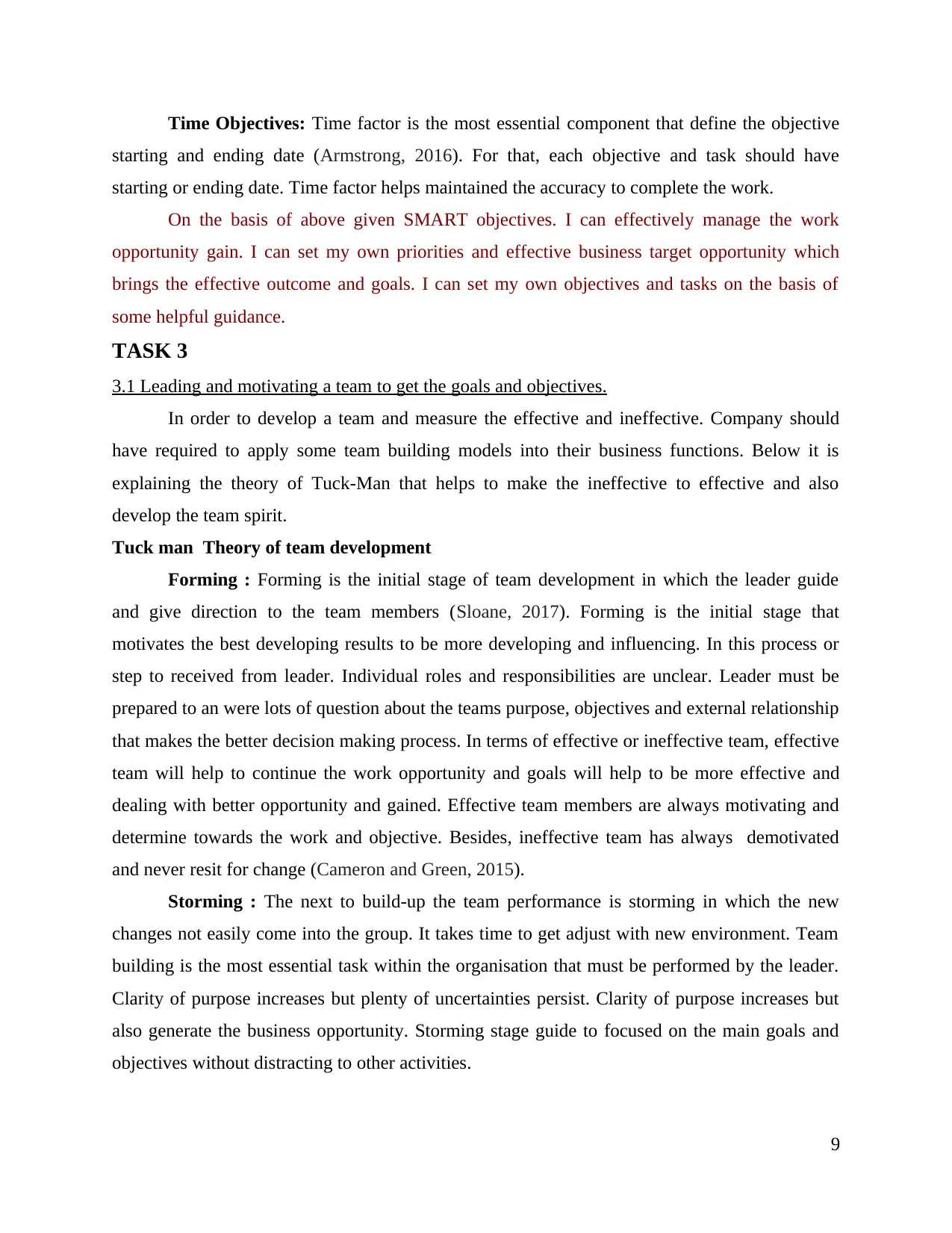
Time Objectives: Time factor is the most essential component that define the objective
starting and ending date (Armstrong, 2016). For that, each objective and task should have
starting or ending date. Time factor helps maintained the accuracy to complete the work.
On the basis of above given SMART objectives. I can effectively manage the work
opportunity gain. I can set my own priorities and effective business target opportunity which
brings the effective outcome and goals. I can set my own objectives and tasks on the basis of
some helpful guidance.
TASK 3
3.1 Leading and motivating a team to get the goals and objectives.
In order to develop a team and measure the effective and ineffective. Company should
have required to apply some team building models into their business functions. Below it is
explaining the theory of Tuck-Man that helps to make the ineffective to effective and also
develop the team spirit.
Tuck man Theory of team development
Forming : Forming is the initial stage of team development in which the leader guide
and give direction to the team members (Sloane, 2017). Forming is the initial stage that
motivates the best developing results to be more developing and influencing. In this process or
step to received from leader. Individual roles and responsibilities are unclear. Leader must be
prepared to an were lots of question about the teams purpose, objectives and external relationship
that makes the better decision making process. In terms of effective or ineffective team, effective
team will help to continue the work opportunity and goals will help to be more effective and
dealing with better opportunity and gained. Effective team members are always motivating and
determine towards the work and objective. Besides, ineffective team has always demotivated
and never resit for change (Cameron and Green, 2015).
Storming : The next to build-up the team performance is storming in which the new
changes not easily come into the group. It takes time to get adjust with new environment. Team
building is the most essential task within the organisation that must be performed by the leader.
Clarity of purpose increases but plenty of uncertainties persist. Clarity of purpose increases but
also generate the business opportunity. Storming stage guide to focused on the main goals and
objectives without distracting to other activities.
9
starting and ending date (Armstrong, 2016). For that, each objective and task should have
starting or ending date. Time factor helps maintained the accuracy to complete the work.
On the basis of above given SMART objectives. I can effectively manage the work
opportunity gain. I can set my own priorities and effective business target opportunity which
brings the effective outcome and goals. I can set my own objectives and tasks on the basis of
some helpful guidance.
TASK 3
3.1 Leading and motivating a team to get the goals and objectives.
In order to develop a team and measure the effective and ineffective. Company should
have required to apply some team building models into their business functions. Below it is
explaining the theory of Tuck-Man that helps to make the ineffective to effective and also
develop the team spirit.
Tuck man Theory of team development
Forming : Forming is the initial stage of team development in which the leader guide
and give direction to the team members (Sloane, 2017). Forming is the initial stage that
motivates the best developing results to be more developing and influencing. In this process or
step to received from leader. Individual roles and responsibilities are unclear. Leader must be
prepared to an were lots of question about the teams purpose, objectives and external relationship
that makes the better decision making process. In terms of effective or ineffective team, effective
team will help to continue the work opportunity and goals will help to be more effective and
dealing with better opportunity and gained. Effective team members are always motivating and
determine towards the work and objective. Besides, ineffective team has always demotivated
and never resit for change (Cameron and Green, 2015).
Storming : The next to build-up the team performance is storming in which the new
changes not easily come into the group. It takes time to get adjust with new environment. Team
building is the most essential task within the organisation that must be performed by the leader.
Clarity of purpose increases but plenty of uncertainties persist. Clarity of purpose increases but
also generate the business opportunity. Storming stage guide to focused on the main goals and
objectives without distracting to other activities.
9
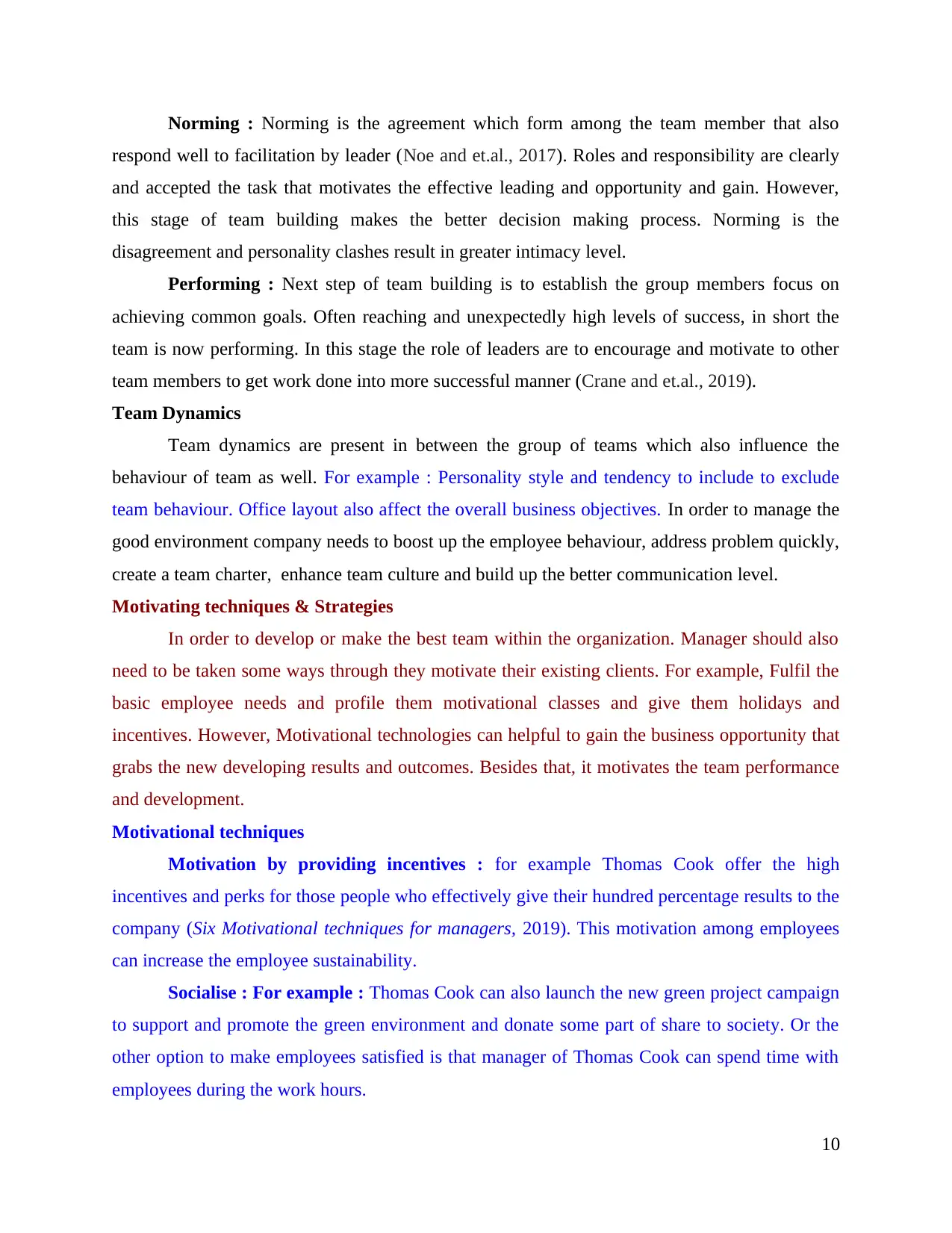
Norming : Norming is the agreement which form among the team member that also
respond well to facilitation by leader (Noe and et.al., 2017). Roles and responsibility are clearly
and accepted the task that motivates the effective leading and opportunity and gain. However,
this stage of team building makes the better decision making process. Norming is the
disagreement and personality clashes result in greater intimacy level.
Performing : Next step of team building is to establish the group members focus on
achieving common goals. Often reaching and unexpectedly high levels of success, in short the
team is now performing. In this stage the role of leaders are to encourage and motivate to other
team members to get work done into more successful manner (Crane and et.al., 2019).
Team Dynamics
Team dynamics are present in between the group of teams which also influence the
behaviour of team as well. For example : Personality style and tendency to include to exclude
team behaviour. Office layout also affect the overall business objectives. In order to manage the
good environment company needs to boost up the employee behaviour, address problem quickly,
create a team charter, enhance team culture and build up the better communication level.
Motivating techniques & Strategies
In order to develop or make the best team within the organization. Manager should also
need to be taken some ways through they motivate their existing clients. For example, Fulfil the
basic employee needs and profile them motivational classes and give them holidays and
incentives. However, Motivational technologies can helpful to gain the business opportunity that
grabs the new developing results and outcomes. Besides that, it motivates the team performance
and development.
Motivational techniques
Motivation by providing incentives : for example Thomas Cook offer the high
incentives and perks for those people who effectively give their hundred percentage results to the
company (Six Motivational techniques for managers, 2019). This motivation among employees
can increase the employee sustainability.
Socialise : For example : Thomas Cook can also launch the new green project campaign
to support and promote the green environment and donate some part of share to society. Or the
other option to make employees satisfied is that manager of Thomas Cook can spend time with
employees during the work hours.
10
respond well to facilitation by leader (Noe and et.al., 2017). Roles and responsibility are clearly
and accepted the task that motivates the effective leading and opportunity and gain. However,
this stage of team building makes the better decision making process. Norming is the
disagreement and personality clashes result in greater intimacy level.
Performing : Next step of team building is to establish the group members focus on
achieving common goals. Often reaching and unexpectedly high levels of success, in short the
team is now performing. In this stage the role of leaders are to encourage and motivate to other
team members to get work done into more successful manner (Crane and et.al., 2019).
Team Dynamics
Team dynamics are present in between the group of teams which also influence the
behaviour of team as well. For example : Personality style and tendency to include to exclude
team behaviour. Office layout also affect the overall business objectives. In order to manage the
good environment company needs to boost up the employee behaviour, address problem quickly,
create a team charter, enhance team culture and build up the better communication level.
Motivating techniques & Strategies
In order to develop or make the best team within the organization. Manager should also
need to be taken some ways through they motivate their existing clients. For example, Fulfil the
basic employee needs and profile them motivational classes and give them holidays and
incentives. However, Motivational technologies can helpful to gain the business opportunity that
grabs the new developing results and outcomes. Besides that, it motivates the team performance
and development.
Motivational techniques
Motivation by providing incentives : for example Thomas Cook offer the high
incentives and perks for those people who effectively give their hundred percentage results to the
company (Six Motivational techniques for managers, 2019). This motivation among employees
can increase the employee sustainability.
Socialise : For example : Thomas Cook can also launch the new green project campaign
to support and promote the green environment and donate some part of share to society. Or the
other option to make employees satisfied is that manager of Thomas Cook can spend time with
employees during the work hours.
10
⊘ This is a preview!⊘
Do you want full access?
Subscribe today to unlock all pages.

Trusted by 1+ million students worldwide
1 out of 18
Related Documents
Your All-in-One AI-Powered Toolkit for Academic Success.
+13062052269
info@desklib.com
Available 24*7 on WhatsApp / Email
![[object Object]](/_next/static/media/star-bottom.7253800d.svg)
Unlock your academic potential
Copyright © 2020–2025 A2Z Services. All Rights Reserved. Developed and managed by ZUCOL.




